Decades: Compiling the Ultimate Library with George Paterson
The Decades Library continues to grow and it is scaling up beyond anything I could ever have imagined. I started this project back in January 2021 when it was dark outside and the rain was lashing against my windows. Now here we are in September 2022 and, despite being in Scotland, the sun is shining and this is the 20th consecutive month where a guest curator is adding new books to my Library.
What is the Decades Library? It is the collection of the very best books as recommended by authors, bloggers, publishers and journalists – booklovers all. I want my Decades Library to represent the stories my guests loved – childhood favourites, memorable reads or just the stories which blew them away.
My guests are all given the same two rules: Nominate five books to my Decades Library. But they can only pick one book per decade over five consecutive decades – a fifty year publication span. Easy? Have a go and see if you can pick your own favourites.
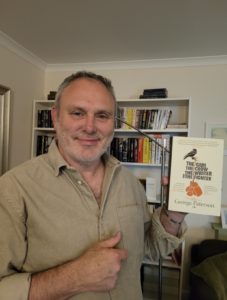 As September is Bloody Scotland month it is my absolute pleasure to welcome George Paterson – author of The Girl, The Crow, The Writer and the Fighter – shortlisted for the 2022 Bloody Scotland Debut Prize.
As September is Bloody Scotland month it is my absolute pleasure to welcome George Paterson – author of The Girl, The Crow, The Writer and the Fighter – shortlisted for the 2022 Bloody Scotland Debut Prize.
George is a writer, DJ and musician who, as a member of the bands White and DMP, released a number of well received albums on the Poco Alto Label. His work can be found in a number of independent feature length and short films as well as providing the musical backdrop to the London stage production of the play, ‘ISM’.
Since returning to Scotland in 2017, his focus has been split between the spoken word – his popular weekly ‘Lost in Music’ radio show – and the written, with articles appearing in a number of online publications before finding a home as a regular features writer and reviewer for INTO Creative.
In addition, he has written two screenplays and one feature length ‘coming of age’ story, serialised on INTO, called ‘Everybody Wants to Rule the World’.
DECADES
 1930’s – The Conjure-Man Dies by Rudolph Fisher
1930’s – The Conjure-Man Dies by Rudolph Fisher
Coming two years after Dashiel Hammett’s no-nonsense game-changer ‘The Maltese Falcon’, Ivy League educated doctor and musician Rudolph Fisher delivered his own murder mystery, the thoroughly entertaining The Conjure-Man Dies. Written and set during Harlem’s 1930’s renaissance, it starts as many great tales do, with a mysterious death in the dark of night, in this instance, Frimbo, the titular ‘Conjure-Man’.
When 7th Avenue physician John Archer is called to the scene of the crime by a pair of local rascals named Jinx and Bubber, Perry Dart of the Harlem PD arrives to investigate the who do – and the voodoo – of this particular unusual case.
I came to this book relatively late – and too late for it to be influential in my own period piece – but I often ponder how ‘The Girl, The Crow, The Writer and The Fighter’ might have worked had I found Fisher’s expertly written piece before I did Hammett’s. Nevertheless, for New Yorkophiles (is that a word?) such as I, The Conjure-Man Dies puts flesh on the bones of a complex but fascinating era and a genre that until Chester Himes in the late 50’s was almost extinct.
Sadly, Rudolph Fisher died shortly after publication which meant that we never got a chance to find out whether Dr Archer and Perry Dart had the ‘legs’ that Nick and Nora and Sam Spade had.
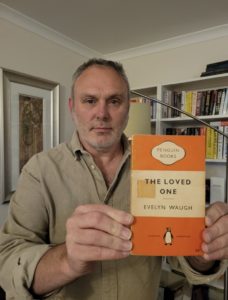 1940’s – The Loved One by Evelyn Waugh
1940’s – The Loved One by Evelyn Waugh
Back in the early 80’s, I was a smart but aimless student at a crumbling state school on Glasgow’s southside. The interest in fiction that I had from primary had not followed me to secondary school. And when it came to my English teachers, they tended to fall into one of two categories; youngish educators who wanted to be your pal or bitter careerists who loved nothing more than to belt out their frustrations onto your hands. By the time I’d reached fifth year, I was pretty much killing time until I was forced out into the workplace. That’s when I met Mr O’Hagan. He didn’t want to be my pal nor did he want to thrash the shite out of me. Curt and precise, he was all business. To his eternal credit, he saw something in me that his predecessors didn’t and that came about after he handed the class battered copies of Evelyn Waugh’s 1948 novel, The Loved One. Oh no, we all thought. I knew he’d written Brideshead Revisited, the recently aired (and very foppish) TV adaptation was so detached from my damp tenement reality that the august realm of the Ryder’s Brideshead estate might as well have been on the fucking moon. However, The Loved One was a short book – 125 pages in the Penguin edition – so it wouldn’t take us long to rattle through it and move onto something less boring. However, by the time Baby Aaronson had been sliced into shape and turned into Juanita del Pablo on page ten, I was already sold. When Mr O’Hagan started asking us what we’d thought of the book, he received the usual shrugs and mumbled ‘Ah dunno’s from most of my fellow pupils. But I got it. And he got that I got it, which must have been a rare mark in the win column for him.
I found The Loved One immoral and unashamedly godless but more importantly for teenaged me, it was incredibly funny. Waugh’s matter-of-fact characterisations coupled with his savage twin takedown of Golden era Hollywood and the industries of death and perennial beauty lit a fire (or a pyre) in me that will never be extinguished. I strolled through my English exam that year and it was all down to Mr O’Hagan and Evelyn Waugh.
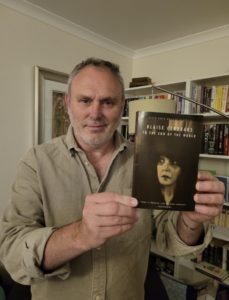 1950’s – To The End of the World by Blaise Cendrars
1950’s – To The End of the World by Blaise Cendrars
A friend to Modigliani, Chagall and Cocteau, Blaise Cendrars was one of the most effervescent, vital artists of the 20th century. Part poet and part warrior – he lost an arm in battle during the Great War – Cendrars squeezed the juices from life and it’s reflected in his work. A hugely influential and encouraging figure, not just in the pre war literary scene in Paris, but in the nascent careers of writers such as Henry Miller, who venerated the Swiss/Scot as his ‘greatest idol’, Cendrars wrote the riotous ‘To The End of the World’ in 1956. He may have been coming to the end of his own journey but as a writer, he remained full of muscle and cheek, daring his contemporaries to have a go. During the writing of my debut novel – which you can find here…shameless plug…intocreative.co.uk/shop – this book, along with Miller’s own ‘Quiet Days in Clichy’, remains as vivid and descriptive a portrayal of the Parisienne underbelly as anything I’ve ever read. As invaluable as a ream of red-marked treasure maps.
An elderly actress, a young legionnaire on the run, murder, sex, laughs. Madmen on every floor. Even in his latter years – and he would only complete two more works after this – Cendrars has a lust for …well, lust that would shame writers a quarter his age.
I can think of precious few modern writers who would dare pick up the cudgels and follow Cendrars and the literary world is poorer for it.
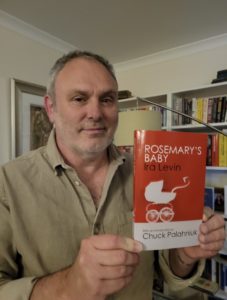 1960’s – Rosemary’s Baby by Ira Levin
1960’s – Rosemary’s Baby by Ira Levin
Stephen King said that Ira Levin was ‘The Swiss Watchmaker of the suspense novel; he makes what the rest of us do look like those five-dollar watches you can buy in a discount drug store.’
A million selling book in 1967 which became an Oscar winning film the following year, Rosemary’s Baby, is in my opinion, a masterclass in pacing, plot, dialogue and black, black humour. Set in an exclusive New York apartment block, young, aspirational couple Rosemary and Guy Woodhouse find that the whispers of malevolent behavior at their new residence are based in a terrible reality. As Guy’s acting career begins to take off, Rosemary descends into a satanic fever dream with heinous consequences.
Levin’s economy of language and his ability to conjure up a sense of the deepest dread from the seemingly mundane has stayed with me since I first read the book, four decades ago. And his fingerprints (or should that be claw marks?) are all over my current work-in-progress; a gothic thriller set in our own Upper West Side, Glasgow’s West End. Aiming for Levin is what I intend to do with ‘Westerwick’. It’s a very tall order but at worst, it’ll have its father’s eyes.
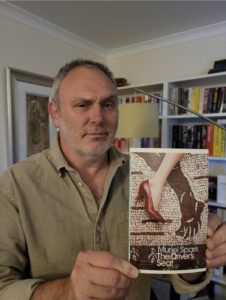 1970’s – The Driver’s Seat by Muriel Spark
1970’s – The Driver’s Seat by Muriel Spark
Unflinching, uncompromising and unlike anything I’ve ever read.
Muriel Spark is one of my go-to writers. If you’re after the florid, you won’t find it here. As with her note perfect, ‘The Prime of Miss Jean Brodie’ there is no other writer who can simultaneously cleave fat from the flesh like a butcher yet trace a narrative as precisely as a neurosurgeon. Not only is it her most stark, brutal story, Spark herself considered it one of her own favourite works.
Set in the late 1960’s, an era of female emancipation, it tells of Lise, an office worker from Northern Europe who decides, without wishing to spoil the story, that she will be the captain of her own fate. I don’t wish to say anymore about this disconcerting book other than, just go read it. Today.
It might not be to everyone’s tastes but for me ‘The Driver’s Seat’ remains a work of immense artistic bravery.
And that’s it! Quite tough calls to be made but I guess that as a writer, I’ve gone for books that continually push their way into my work space rather than those which I might return to purely for entertainment. I’ll continue to use all of those influences and distill the essence of their work and with any luck, I’ll concoct my own heady brew.
If I’m invited back onto Decades further down the line, I’ll change course around 1980 and head for home!
Spectacular mix of books, thanks to George for these fascinating selections. This is the second week in a row where there have been five entirely new novels nominated – it swells the total books offered to Library visitors and I hope it swells your TBR piles too.